5 Things You Need to Know About Cupid
Cupid is the ancient Roman god of love and the counterpart to the Greek god Eros. It’s him who inspires us to fall in love, write love songs...
Valeria Kumekina 14 June 2024
Just about all of us have a tiny inkling about Impressionism, the Renaissance, maybe even Expressionism, and what makes each movement different from the other. However, when it comes to the Pre-Raphaelites most people, including myself, would have had little to no knowledge about them. But wonder no more! Here you will learn some new conversation starters, as we take a look at ten facts about the Pre-Raphaelites!
With a name like the Pre-Raphaelites, you would probably assume this group of artists lived and worked before Raphael. Seems logical, right? Alas, it isn’t how the story goes. The group got its start in London in 1848, some 300 years or so after Raphael’s heyday during the Italian Renaissance.
Their name is actually a reference to their preference for Italian artists who came before Raphael and Michelangelo. Dante Gabriel Rossetti, William Hunt, and John Everett Millais all preferred the works of Sandro Botticelli, Domenico Ghirlandaio, and Pietro Perugino. Each artist looked to the artists of the late medieval period and emulated their qualities, such as their use of brilliant colors, moralizing subject matters, and the depiction of even the smallest of details.
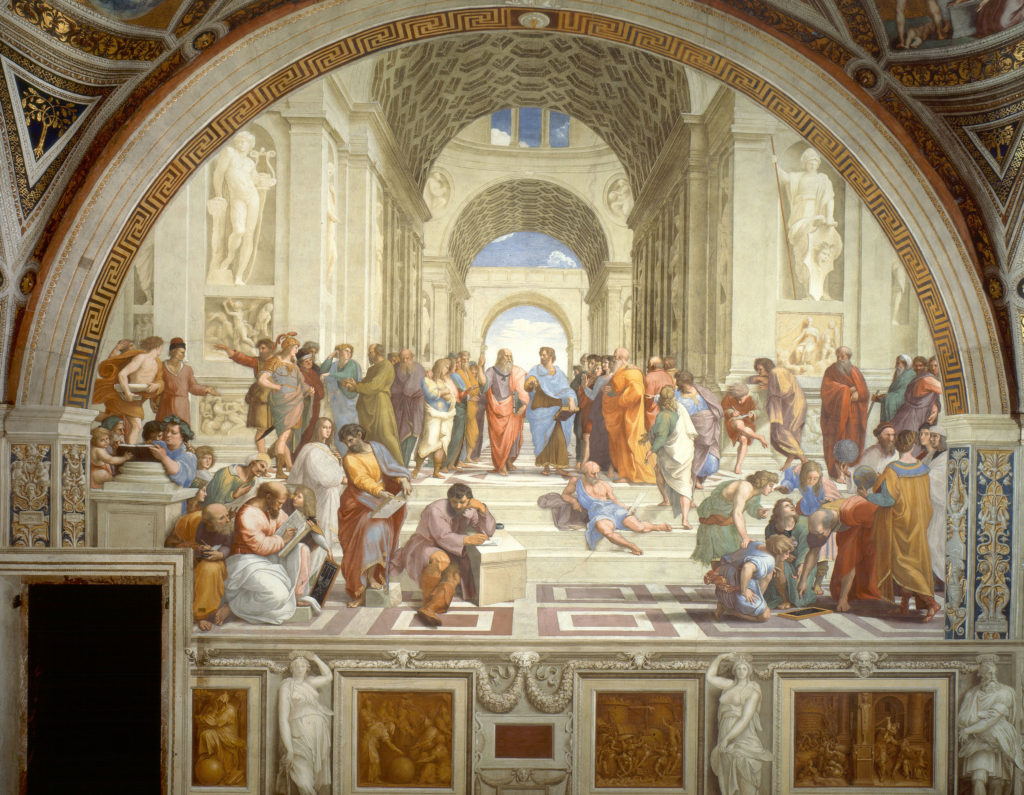
It all began at the Royal Academy’s exhibition of 1848. Artist and poet, Dante Gabriel Rossetti, saw William Holman Hunt’s painting, The Eve of Saint Agnes, which was unusual for a painting at that time because it was inspired by poetry. Rossetti sought out Hunt and the pair quickly became friends. A little later, Hunt introduced Rossetti to John Everett Millais and the trio formed the secret society, the Pre-Raphaelite Brotherhood.
While it was a secret at first, it was not kept for long, not once the public started finding out about them. The artists exhibited their works publicly and also published a magazine promoting and spreading their ideas about art and literature.
In much the same way as any other type of musical, artistic, or even societal evolution, it all began with a small group of artists whose ideas differed drastically from the majority. The Pre-Raphaelites were free thinkers. The youngsters modeled themselves after the Nazarene Brotherhood and rebelled against the Royal Academy’s promotion of the middle class’s mediocre tastes for eclecticism, sentimentality, and sensationalism. These rebels also criticized the Royal Academy for allowing the standards of painting to deteriorate. They sought to transform the artistic establishment of Victorian England.
At the time, England found itself in the midst of political upheaval, mass industrialization, and abundant social issues. When the Brotherhood began, they sought to transmit a message of artistic renewal and moral reform; by filling their art with seriousness, sincerity, and faithfulness to nature not seen in their contemporaries’ work.
John Ruskin’s two-volume book, Modern Painters, was very important to the Pre-Raphaelites. In the first volume, Ruskin scoffed at the Academy’s fan base that was so easily impressed by “tricks of the brush” or a “grimace of expression” but blind to art of “noble conception and perfect truth.” Sounds familiar, right? We could assume this book validated the Pre-Raphaelite cause.
Ruskin’s writing also encouraged the artists to “go to nature in all singleness of heart… Rejecting nothing, selecting nothing, and scorning nothing” so they could more closely study and observe nature. In turn, this allowed them to capture an honest realism that Ruskin admired.
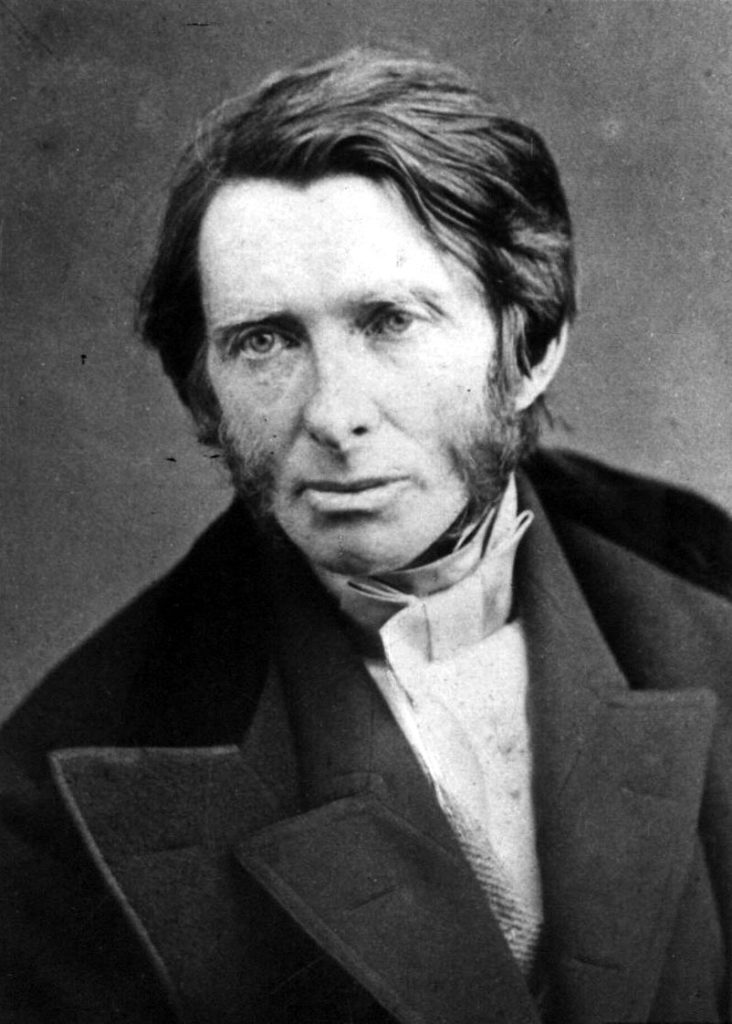


Initially, their themes were religious as seen in paintings such as Millais’, Christ in the Carpenter’s Shop, and Rossetti’s, Ecce Ancilla Domini (Behold the handmaid of the Lord). However, to stick to their abandonment of genre scenes and to perhaps have more success at exhibitions, the Brotherhood turned to literary subjects for inspiration; especially those dealing with love and death. Shakespeare’s plays, The Bible, and the Arthurian legends all became typical subjects for the Pre-Raphaelites.
Just like their literary counterparts, the Pre-Raphaelites became known for infusing their art with symbolic meaning. Their detailed, hyper-realistic style gave way to a mode of painting usually referred to as Symbolic Realism.
For example, in Millais’, Christ in the Carpenter’s Shop, there are many symbols referring to biblical themes. The scene depicts Mary kneeling by Jesus, she is comforting him as Joseph bandages his hand which has been pierced with a nail, foreshadowing his crucifixion. On the right, a young John the Baptist carries a bowl of water, an allusion to his role in baptizing Christ. Behind the figures, we see a carpenter’s triangle hanging on the wall, symbolizing the Holy Trinity. Just to the right, we see a white dove perched on the ladder, symbolizing the Holy Spirit. Through the doorway, a flock of sheep is visible and metaphorically represents Christ’s followers.
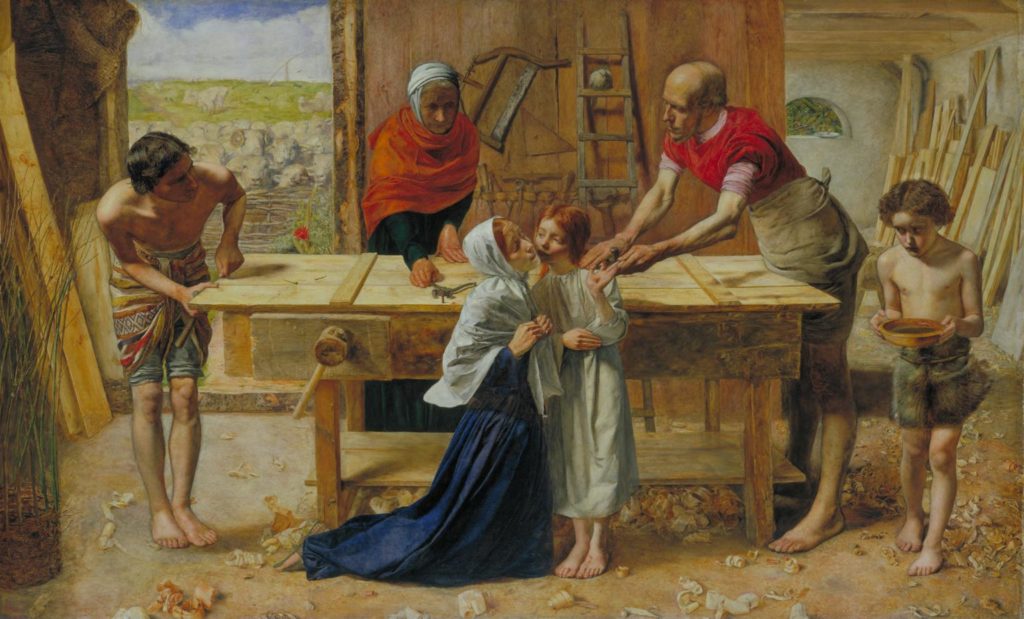


Despite the change the Pre-Raphaelites hoped to bring, they were not immediately successful. The artists all exhibited their works at the National Institution, the Free Exhibition, and even the Royal Academy. But they did so anonymously, choosing to sign their work with “PRB” rather than their own names. Alas, they were met with critical opposition to their piety, lack of shadows, flattened forms, and use of crisp colors.
Millais’ painting, Christ in the Carpenter’s Shop was heavily criticized for showing the biblical figures as regular people in a normal setting. Charles Dickens called the Christ child: “a hideous, wry-necked, blubbering, red-haired boy in a nightgown” and found the Virgin “so horrible in her ugliness that (supposing it were possible for any human creature to exist for a moment with that dislocated throat) she would stand out from the rest of the company as a monster in the vilest cabaret in France or in the lowest gin shop in England.”
This painting created such a scandal that Queen Victoria demanded it is brought to her so she could judge it herself.
When most of us think of painting en plein air, or outside, we think of the Impressionists, especially our friends Van Gogh and Monet. However, the Pre-Raphaelites were some of the first artists to complete portions of their canvases outside. This dedication to nature and representing it in minute detail sets the Pre-Raphaelites apart and shows the influence of Ruskin’s writing.
One of the most famous examples of this is John Everett Millais’ painting, The Death of Ophelia. He has accurately and beautifully captured this tragic moment in Shakespeare’s Hamlet. Before he began painting Ophelia, Millais spent five months painting the river and its banks, carefully depicting the willows and the beautiful flowers. He would often spend 11 hours at a time painting in this spot!
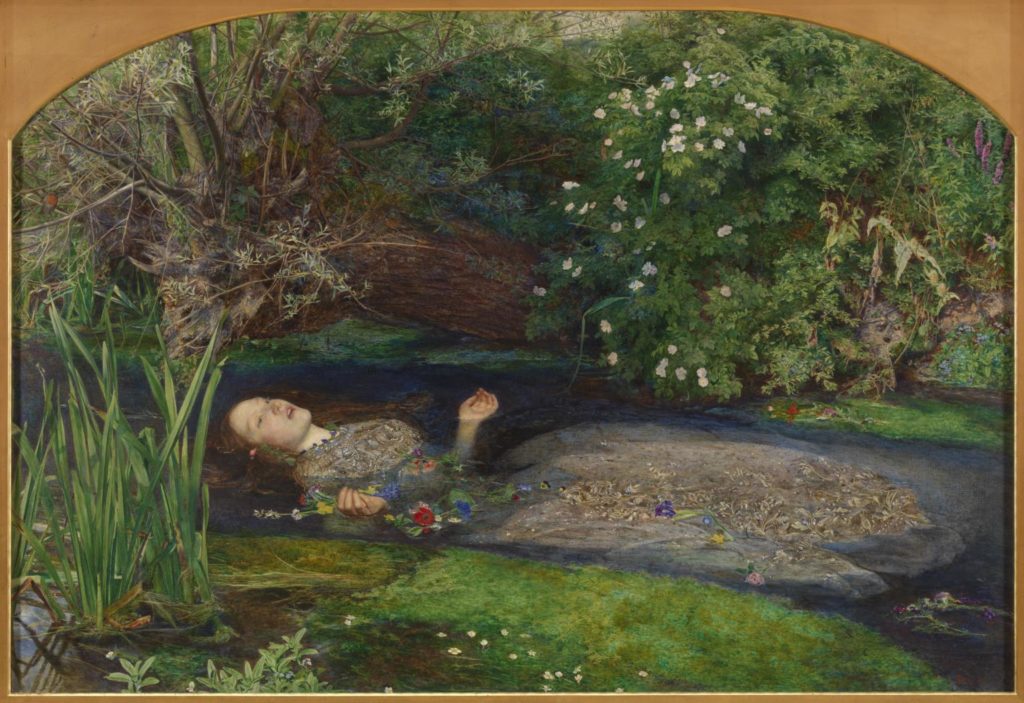
While the Pre-Raphaelites made a pact to leave genre painting behind, they did find drawing inspiration from modern life could be useful. Especially since religious paintings were not bringing them much success or recognition. As it turns out, creating imagery that brings social and moral issues to the forefront is best done through genre painting.
William Holman Hunt’s painting The Awakening Conscience is a perfect example. In this work, we see a young woman, perhaps a prostitute or maybe simply his lover, rising from a man’s lap. As she gazes out the window we see reflected in the mirror, that she realizes the evil of her ways. The cat playing with the injured bird under the table symbolizes her predicament while the tangled yarn on the floor represents the web she has been stuck in.
In order to show his disapproval of the situation, Hunt has meticulously depicted the lavish material items surrounding the couple, to highlight the distraction from spiritual matters these possessions create. Just in case that wasn’t enough, Hunt also had Bible verses inscribed around the frame and printed in the exhibition booklet. Nonetheless, critics were too preoccupied with its scandalous subject rather than with the painting’s true message. It’s almost as if they were saying, “How dare you criticize how I live my life!”
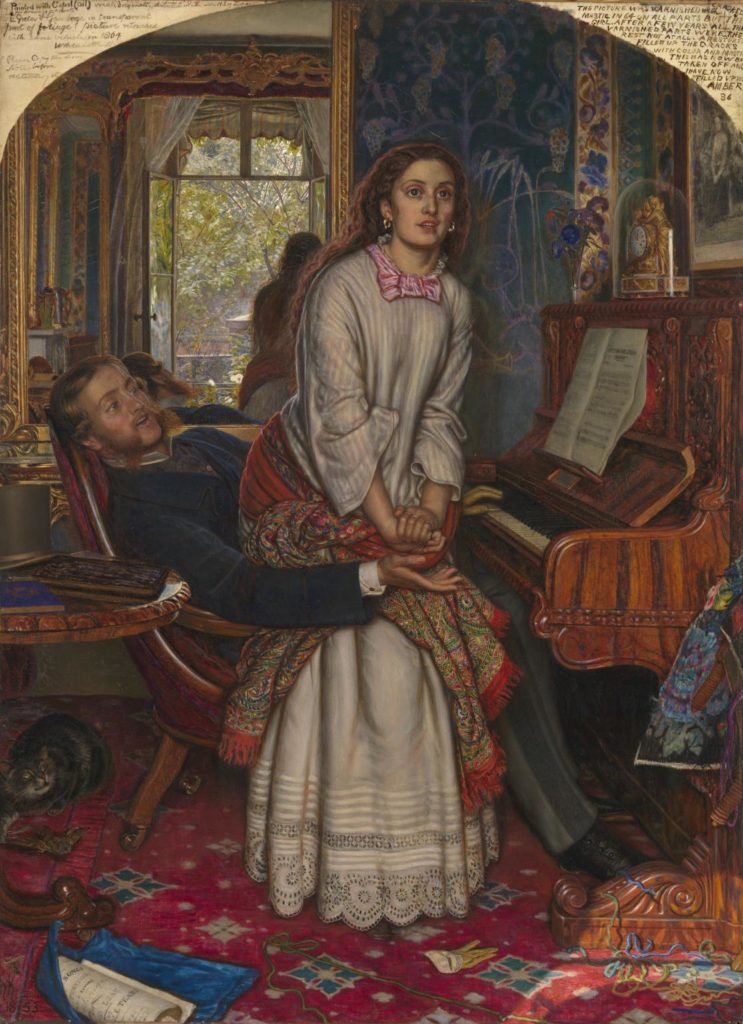


Early on, it was decided that seven was the appropriate number for the rebellious group. Thus, four new members were inducted into the society. These new additions continue to mystify scholars. Painter, James Collinson, appears to have been added because of his short-lived engagement to Rossetti’s sister rather than his dedication to the cause. Thomas Woolner, a sculptor was also added. Oddly enough, the other two newbies, William Michael Rossetti, and Frederic George Stephens, both went on to become art critics and were not practicing artists.
While their numbers were few, the Pre-Raphaelites did go on to attract followers. Two such cases are Walter Howell Deverell and Charles Collins. Both embraced the Brotherhood’s ideals but were never formally inducted as members.
The Germ was established by Rossetti, Hunt, and Millais in 1850 just as the Pre-Raphaelites were forming. Being Rossetti’s brainchild, the magazine was created as a means for the Brotherhood to circulate and perhaps promote the radical ideas and creative work of the Pre-Raphaelites as expressed via literature, poetry, and art. Each issue included poetry, an engraving, and historical or critical essays. Naturally, these essays pertained to subjects relating to the group’s interests, such as early Renaissance painters like Botticelli and Ghirlandaio. Rossetti’s sister, Christina, although not allowed membership into the Brotherhood, was permitted to publish her poetry in the magazine.
After a while, the magazine’s name was changed to Art and Poetry: Being Thoughts towards Nature Conducted Principally by Artists. That’s a mouthful! Much to Rossetti’s disappointment, the magazine sold poorly and was forced to close as the Brotherhood kept on developing.
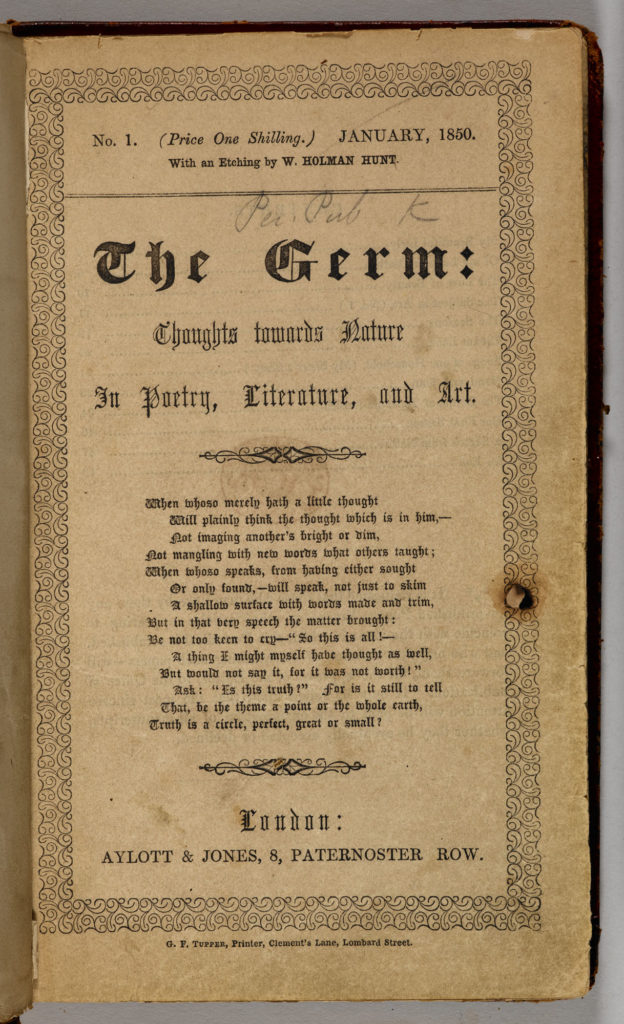
By the mid-1850s, the Pre-Raphaelite Brotherhood began to grow apart. Millais had married and became aware that he, too, had to pander to middle-class tastes in order to provide for his family. Hunt was still very interested in religious themes. As a result, he took several trips to the Holy Land to gain more insight into his subject matter. After facing a negative reception, Rossetti became reticent about showing his work but took a new interest in poetry. Woolner emigrated to Australia, making the group officially separated.
However, Rossetti stated that the official dissolution of the Brotherhood happened when Millais was elected as an associate of the Royal Academy in 1853. Perhaps he felt betrayed that Millais was joining the very establishment they had previously fought to change. However, it likely allowed Millais to fight for change on a larger scale, especially as he would go on to become quite a successful artist.
While the Brotherhood was short-lived and may not seem to be as serious as they claimed, their work has had a lasting impact on art history. These artists were some of the first to truly value painting outside. Additionally, their efforts to band together to fight the establishment paved the way for later artists to do the same. What they began even helped to shape the Arts and Crafts movement that brought fine art and crafting together. Their distinct themes, attention to detail, and use of color truly set them apart from other Victorian painters.
DailyArt Magazine needs your support. Every contribution, however big or small, is very valuable for our future. Thanks to it, we will be able to sustain and grow the Magazine. Thank you for your help!